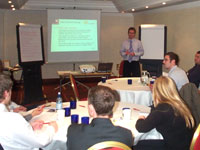Sir David Varney has laid down a series of recommendations for the UK government’s public sector contact centres. If upheld, the plans should revolutionise how they operate.
Alex Coxon reports from a masterclass outlining what public sector contact centres should do to ensure they meet the grade.
In December 2006, Sir David Varney published a report on UK public service delivery and ways to make it more accessible and efficient.
The former executive chairman of HM Revenue & Customs had plenty to say on contact centres – not least that to improve public sector performance, the operating costs of its contact centres needed to be reduced by 25%.
With other recommendations including that all taxpayer-funded contact centres be formally accredited by December 2008 and that key performance indicators (KPIs) and benchmarks should be put in place so contact centres could match themselves against their peers, Varney has certainly presented a challenge to the UK public sector.
But just how should this challenge be taken up? How can public sector contact centres set about making themselves more efficient?
“Contact centres should be planned on the basis of citizens’ and businesses’ needs”
In April, the consultancies RXP and 4C Strategies held the first in a series of masterclasses aimed at addressing this problem. And I was invited along to hear what practical measures they could recommend to those in the public sector. In attendance were a range of organisations, from local councils to universities and hospitals – all of which were about to learn how Varney’s proposals could be tackled.
As for this article… although it would be impossible to go in to minute detail, outlining the different exercises, case studies and approaches the consultants take in their masterclasses, what I want to do here is to summarise some of the key points raised during the day-long event.
Getting a handle on best practice
The first part of the event was aimed at outlining not only the recommendations (as above), but also the best practice principles Varney had suggested could make all the difference to public sector contact centres.
To summarise, these are that:
- Contact centres should be planned on the basis of citizens’ and businesses’ needs rather than product-centric contact strategies.
- Citizen and business demand for contact should be proactively managed.
- Demand for contact should be satisfied through the most efficient use of contact centre resources.
- The management of contact should be seen as a recognised competence.
- Contact centres should attract and retain the most appropriate staff.
- The value of citizen and business knowledge should be exploited to benefit the whole of government.
Condensing this data down, the consultants came to the conclusion that the key things public contact centres need to do are:
- Establish KPIs
- Manage contact ‘waste’
- Establish a focus on ‘right first time’ quality
- Benchmark their operations
How should they go about doing this?
1) Choosing the right KPIs
According to RXP and 4C, there are four types of measurement that need to be borne in mind when creating KPIs: financial; efficiency; effectiveness; and customer-related. This data can come from a number of sources. Your ACD, for example, will give you the low-down on average handling time, while HR systems will tell you about attrition and your finance system will tell you about cost per call.
The consultants’ advice is to create a balanced scorecard using the KPIs you decide are most appropriate for your call centre, drilling down to operational, call centre, team and individual measures.
This approach not only allows managers to do basic things like gauging how many calls need to be made per agent per day, but also helps them see how their KPIs influence different elements of the operation.
Once you’ve got this data to hand, you’re in a better position to benchmark your operation against others. It also helps you to determine what constitutes contact ‘waste’ (see below).
2) Managing contact ‘waste’
Public sector contact centres don’t need to be told much of their time is spent dealing with unintended, avoidable calls.
The key, say the consultants, is to monitor and categorise incoming calls, assessing the scale of ‘no value contacts’ and their corresponding cost. It’s an exercise that must be undertaken continually throughout a contact centre’s lifetime – not just once. And once patterns of data start emerging, that’s when you can start identifying the triggers of avoidable contact and their root causes.
After that, managers can start designing and implementing changes on an ongoing basis – specifically looking at what they can eliminate (for example, by putting better information in direct mail sent to citizens), what they can streamline through better processes, and what they can automate using technology like self-service menus.
3) Establishing a focus on ‘right first time’ quality

Once wastehas been tackled, it’s easier to focus on ‘right first time’ quality. The consultants say that quality can be measured in a number of ways. Externally, it can be gauged through customer surveys and by analysing complaints. Internally, it can be done by matching individual calls against an ‘ideal call’ template, and also by measuring the percentage of errors, re-work and repeat calls.
Team leaders are critical when it comes to internal evaluation. Instead of using them simply to troubleshoot and escalate agent problems to, they should be used as mentors and coaches, offering regular assessment based on their contact centre’s ‘ideal call’ structure, and providing regular feedback and training.
The most important thing is that soft skills such as empathy and speed and tone of the voice are considered in equal measure to an agent’s ability to get through the call in an efficient and timely manner. Quality after all needs to be defined according to the needs of the citizen rather than whatever the contact centre believes that citizen wants.
4) Benchmarking operations
Like establishing quality, benchmarking can done both internally and externally. Mystery shopping and customer surveys are two approaches often undertaken by external benchmarkers, whereas customer satisfaction levels, service levels, staff turnover and absenteeism, agent utilisation and contact data accuracy provide some of the best pieces of information internally.
By cross-correlating these various pieces of data, public sector contact centres can finally start benchmarking themselves both against their previous performance and against their peers.
So, what of the future?
Public sector contact centres have a very real obligation to improve themselves. Varney’s report stipulates clear timelines – including one just 18 months away for accreditation.
Following these four steps is certainly going to help interested parties adhere to that deadline. Equally, it will give them the opportunity to make themselves less frustrating and more interesting places to work.
The following comments have been posted relating to this article:I must say that I have seen a big improvement with the telephone service from my local council since they brought in the contact centre. Before there was just a list of numbers to call that could be very confusing. A lot easier now. (posted by Tim W).
Sir David recommended that all taxpayer call centres be accredited by December 2008. However according to the same report if the call centre has less than 200 seats it will still be considered as inefficient as it falls below the private sector minimum efficient size of 200-400 seats! (posted by Peter W)
Author: Jonty Pearce
Published On: 11th Jun 2007 - Last modified: 15th Aug 2025
Read more about - Customer Service Strategy, Service Strategy















